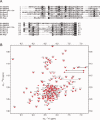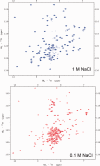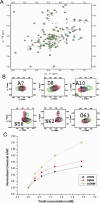Ionic strength-dependent conformations of a ubiquitin-like small archaeal modifier protein (SAMP1) from Haloferax volcanii
- PMID: 23818097
- PMCID: PMC3776330
- DOI: 10.1002/pro.2302
Ionic strength-dependent conformations of a ubiquitin-like small archaeal modifier protein (SAMP1) from Haloferax volcanii
Abstract
Eukaryotic ubiquitin and ubiquitin-like systems play crucial roles in various cellular biological processes. In this work, we determined the solution structure of SAMP1 from Haloferax volcanii by NMR spectroscopy. Under low ionic conditions, SAMP1 presented two distinct conformations, one folded β-grasp and the other disordered. Interestingly, SAMP1 underwent a conformational conversion from disorder to order with ion concentration increasing, indicating that the ordered conformation is the functional form of SAMP1 under the physiological condition of H. volcanii. Furthermore, SAMP1 could interact with proteasome-activating nucleotidase B, supposing a potential role of SAMP1 in the protein degradation pathway mediated by proteasome.
Keywords: Haloferax volcanii; NMR; SAMP1; protein folding; ubiquitin-like protein.
© 2013 The Protein Society.
Figures







Similar articles
-
Ionic strength-dependent conformations of a ubiquitin-like small archaeal modifier protein (SAMP2) from Haloferax volcanii.Sci Rep. 2013;3:2136. doi: 10.1038/srep02136. Sci Rep. 2013. PMID: 23823798 Free PMC article.
-
Crystal structure of the ubiquitin-like small archaeal modifier protein 2 from Haloferax volcanii.Protein Sci. 2013 Sep;22(9):1206-17. doi: 10.1002/pro.2305. Epub 2013 Jul 27. Protein Sci. 2013. PMID: 23821306 Free PMC article.
-
Crystal structure of ubiquitin-like small archaeal modifier protein 1 (SAMP1) from Haloferax volcanii.Biochem Biophys Res Commun. 2011 Feb 4;405(1):112-7. doi: 10.1016/j.bbrc.2011.01.004. Epub 2011 Jan 7. Biochem Biophys Res Commun. 2011. PMID: 21216237
-
A simple technique to improve the resolution of membrane acidic proteins of the haloarchaeon Haloferax volcanii by 2D electrophoresis.Electrophoresis. 2014 Dec;35(24):3518-22. doi: 10.1002/elps.201400407. Epub 2014 Oct 21. Electrophoresis. 2014. PMID: 25224925 Review.
-
Add salt, add sugar: N-glycosylation in Haloferax volcanii.Biochem Soc Trans. 2013 Feb 1;41(1):432-5. doi: 10.1042/BST20120142. Biochem Soc Trans. 2013. PMID: 23356324 Review.
Cited by
-
Prokaryotic ubiquitin-like protein modification.Annu Rev Microbiol. 2014;68:155-75. doi: 10.1146/annurev-micro-091313-103447. Epub 2014 May 29. Annu Rev Microbiol. 2014. PMID: 24995873 Free PMC article. Review.
-
Characterization of the deubiquitination activity and substrate specificity of the chicken ubiquitin-specific protease 1/USP associated factor 1 complex.PLoS One. 2017 Nov 1;12(11):e0186535. doi: 10.1371/journal.pone.0186535. eCollection 2017. PLoS One. 2017. PMID: 29091922 Free PMC article.
-
Mechanism of salt-induced activity enhancement of a marine-derived laccase, Lac15.Eur Biophys J. 2018 Apr;47(3):225-236. doi: 10.1007/s00249-017-1251-5. Epub 2017 Sep 5. Eur Biophys J. 2018. PMID: 28875401
-
Ubiquitin-Like Proteasome System Represents a Eukaryotic-Like Pathway for Targeted Proteolysis in Archaea.mBio. 2016 May 17;7(3):e00379-16. doi: 10.1128/mBio.00379-16. mBio. 2016. PMID: 27190215 Free PMC article.
-
Effects of ionic strength on the folding and stability of SAMP1, a ubiquitin-like halophilic protein.Biophys J. 2022 Feb 15;121(4):552-564. doi: 10.1016/j.bpj.2022.01.010. Epub 2022 Jan 19. Biophys J. 2022. PMID: 35063455 Free PMC article.
References
Publication types
MeSH terms
Substances
LinkOut - more resources
Full Text Sources
Other Literature Sources

